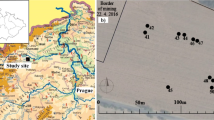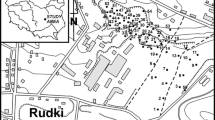Abstract
Uranium contamination due to mining and metallurgical operations is a serious problem worldwide. Upon entering an ecosystem, uranium poses a high potential threat to humans and other organisms. A better understanding of the distribution and speciation of uranium in contaminated soil is therefore necessary over relevant time scales. In this study, we collected uncontaminated soil samples, including eluvial (E), illuvial (B), and parent-material (C) horizons, from a soil profile near a uranium tailing reservoir in southern China. Four columns were filled with the E, B, and C horizons and three types of mixed soil samples to simulate the behavior of uranium in soil near an uranium tailing reservoir. The atomic-scale mechanisms were investigated using X-ray diffraction, X-ray photoelectron spectroscopy, and other characterization methods. The results show that air, clay minerals, iron and manganese oxides, and other soil properties exert important effects on the forms and mobility of uranium in soil, and that ageing leads to a rearrangement and chemical fractionation of uranium in soil.






Similar content being viewed by others
References
Rout S, Kumar A, Ravi PM, Tripathi RM (2016) Understanding the solid phase chemical fractionation of uranium in soil and effect of ageing. J Hazard Mater 317:457–465. https://doi.org/10.1016/j.jhazmat.2016.05.082
Massey MS, Lezama-Pacheco JS, Nelson JM et al (2014) Uranium incorporation into amorphous silica. Environ Sci Technol 48:8636–8644. https://doi.org/10.1021/es501064m
Xu Z, Xing Y, Ren A et al (2020) Study on adsorption properties of water hyacinth—derived biochar for uranium (VI). J Radioanal Nucl Chem 324:1317–1327. https://doi.org/10.1007/s10967-020-07160-2
Lehmann S, Foerstendorf H, Zimmermann T et al (2019) Thermodynamic and structural aspects of the aqueous uranium(iv) system-hydrolysis vs. sulfate complexation. Dalt Trans 48:17898–17907. https://doi.org/10.1039/c9dt02886b
Wang Q, Li T, Huang X, Yang G (2020) Redox mechanism and stability of uranyl phosphites at mineral surfaces: cooperative proton/electron transfer and high efficacy for Uranium(VI) reduction. Chemosphere 255:126948. https://doi.org/10.1016/j.chemosphere.2020.126948
Burns PC (2005) U6+ minerals and inorganic compounds: insights into an expanded structural hierarchy of crystal structures. Can Miner 43:1839–1894. https://doi.org/10.2113/gscanmin.43.6.1839
Forbes TZ, Wallace C, Burns PC (2008) Neptunyl compounds: polyhedron geometries, bond-valence parameters, and structural hierarchy. Can Miner 46:1623–1645. https://doi.org/10.3749/canmin.46.6.1623
Zhang Z, Liu J, Cao X et al (2015) Comparison of U(VI) adsorption onto nanoscale zero-valent iron and red soil in the presence of U(VI)-CO3/Ca-U(VI)-CO3 complexes. J Hazard Mater 300:633–642. https://doi.org/10.1016/j.jhazmat.2015.07.058
Gavrilescu M, Pavel LV, Cretescu I (2009) Characterization and remediation of soils contaminated with uranium. J Hazard Mater 163:475–510. https://doi.org/10.1016/j.jhazmat.2008.07.103
Semenkova A, Belousov P, Rzhevskaia A et al (2020) U (VI) sorption onto natural sorbents. J Radioanal Nucl Chem. https://doi.org/10.1007/s10967-020-07318-y
Fuller AJ, Leary P, Gray ND et al (2020) Organic complexation of U(VI) in reducing soils at a natural analogue site: implications for uranium transport. Chemosphere 254:126859. https://doi.org/10.1016/j.chemosphere.2020.126859
Ma D, Wei J, Zhao Y et al (2020) The removal of uranium using novel temperature sensitive urea-formaldehyde resin: adsorption and fast regeneration. Sci Total Environ 735:139399. https://doi.org/10.1016/j.scitotenv.2020.139399
Cumberland SA, Douglas G, Grice K, Moreau JW (2016) Uranium mobility in organic matter-rich sediments: a review of geological and geochemical processes. Earth-Sci Rev 159:160–185. https://doi.org/10.1016/j.earscirev.2016.05.010
Noël V, Boye K, Kukkadapu RK et al (2019) Uranium storage mechanisms in wet-dry redox cycled sediments. Water Res 152:251–263. https://doi.org/10.1016/j.watres.2018.12.040
Zhang H, Yang C, Tao Z (2009) Effects of phosphate and fulvic acid on the sorption and transport of uranium(VI) on silica column. J Radioanal Nucl Chem 279:317–323. https://doi.org/10.1007/s10967-007-7177-0
Luo W, Gu B (2009) Dissolution and mobilization of uranium in a reduced sediment by natural humic substances under anaerobic conditions. Environ Sci Technol 43:152–156. https://doi.org/10.1021/es8013979
Yang Y, Saiers JE, Xu N et al (2012) Impact of natural organic matter on uranium transport through saturated geologic materials: from molecular to column scale. Environ Sci Technol 46:5931–5938. https://doi.org/10.1021/es300155j
Equeenuddin SM, Akhtar S, Bastia F et al (2020) Role of colloid in metal transport in river water around Jaduguda uranium mines, Singhbhum shear zone. J Earth Syst Sci 129:1–9. https://doi.org/10.1007/s12040-019-1262-y
Zhou P, Gu B (2005) Extraction of oxidized and reduced forms of uranium from contaminated soils: effects of carbonate concentration and pH. Environ Sci Technol 39:4435–4440. https://doi.org/10.1021/es0483443
Santos EA, Ladeira ACQ (2011) Recovery of uranium from mine waste by leaching with carbonate-based reagents. Environ Sci Technol 45:3591–3597. https://doi.org/10.1021/es2002056
Cheng T, Barnett MO, Roden EE, Zhuang J (2004) Effects of phosphate on uranium(VI) adsorption to goethite-coated sand. Environ Sci Technol 38:6059–6065. https://doi.org/10.1021/es040388o
Shang J, Liu C, Wang Z, Zachara JM (2011) Effect of grain size on uranium(VI) surface complexation kinetics and adsorption additivity. Environ Sci Technol 45:6025–6031. https://doi.org/10.1021/es200920k
Echevarria G, Sheppard MI, Morel JL (2001) Effect of pH on the sorption of uranium in soils. J Environ Radioact 53:257–264. https://doi.org/10.1016/S0265-931X(00)00116-8
Rout S, Ravi PM, Kumar A, Tripathi RM (2015) Study on speciation and salinity-induced mobility of uranium from soil. Environ Earth Sci 74:2273–2281. https://doi.org/10.1007/s12665-015-4218-9
Yang S, Zhang X, Wu X et al (2019) Understanding the solid phase chemical fractionation of uranium in soil profile near a hydrometallurgical factory. Chemosphere 236:1–10. https://doi.org/10.1016/j.chemosphere.2019.124392
Pérez-Moreno SM, Gázquez MJ, Pérez-López R, Bolivar JP (2018) Validation of the BCR sequential extraction procedure for natural radionuclides. Chemosphere 198:397–408. https://doi.org/10.1016/j.chemosphere.2018.01.108
Dainyak LG, Drits VA (2009) A model for the interpretation of Mossbauer spectra of muscovite. Eur J Miner 21:99–106. https://doi.org/10.1127/0935-1221/2008/0020-1835
Novikov AP, Kalmykov SN, Utsunomiya S et al (2006) Colloid transport of plutonium in the far-field of the Mayak Production Association, Russia. Science 314:638–641. https://doi.org/10.1126/science.1131307
Ahmed H, Young SD, Shaw G (2014) Factors affecting uranium and thorium fractionation and profile distribution in contrasting arable and woodland soils. J Geochem Explor 145:98–105. https://doi.org/10.1016/j.gexplo.2014.05.017
Claveranne-Lamolre C, Aupiais J, Lespes G et al (2011) Investigation of uranium-colloid interactions in soil by dual field-flow fractionation/capillary electrophoresis hyphenated with inductively coupled plasma-mass spectrometry. Talanta 85:2504–2510. https://doi.org/10.1016/j.talanta.2011.07.100
Filgueiras AV, Lavilla I, Bendicho C (2002) Chemical sequential extraction for metal partitioning in environmental solid samples. J Environ Monit 4:823–857. https://doi.org/10.1039/b207574c
Law GTW, Geissler A, Burke IT et al (2011) Uranium redox cycling in sediment and biomineral systems. Geomicrobiol J 28:497–506. https://doi.org/10.1080/01490451.2010.512033
Sani RK, Peyton BM, Dohnalkova A, Amonette JE (2005) Reoxidation of reduced uranium with iron(III) (Hydr)oxides under sulfate-reducing conditions. Environ Sci Technol 39:2059–2066. https://doi.org/10.1021/es0494297
Koch-Steindl H, Pröhl G (2001) Considerations on the behaviour of long-lived radionuclides in the soil. Radiat Environ Biophys 40:93–104. https://doi.org/10.1007/s004110100098
Wang Z, Lee SW, Kapoor P et al (2013) Uraninite oxidation and dissolution induced by manganese oxide: a redox reaction between two insoluble minerals. Geochim Cosmochim Acta 100:24–40. https://doi.org/10.1016/j.gca.2012.09.053
Alaqarbeh M, Khalili FI, Kanoun O (2020) Manganese ferrite (MnFe2O4) as potential nanosorbent for adsorption of uranium(VI) and thorium(IV). J Radioanal Nucl Chem 323:515–537. https://doi.org/10.1007/s10967-019-06953-4
Acknowledgements
This study was supported by the National Natural Science Foundation of China (Grant No. 51874180, No. 51704169), the Hunan Provincial Department of Education Scientific Research Project (Grant No. 19A417), and the Science and Technology Planning Project of Hunan Province. (Grant No. 2019RS2042).
Author information
Authors and Affiliations
Corresponding author
Additional information
Publisher's Note
Springer Nature remains neutral with regard to jurisdictional claims in published maps and institutional affiliations.
Rights and permissions
About this article
Cite this article
He, W., Zhang, X., Wu, X. et al. Effects of ageing on the occurrence form of uranium in vertical soil layers near an uranium tailing reservoir. J Radioanal Nucl Chem 327, 847–856 (2021). https://doi.org/10.1007/s10967-020-07552-4
Received:
Accepted:
Published:
Issue Date:
DOI: https://doi.org/10.1007/s10967-020-07552-4




